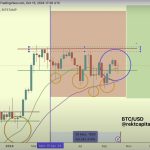Recent trends indicate a fascinating shift in Ethereum’s market dynamics, with exchange reserves falling to a significant low. This decline in reserves could hint at an increasing demand for Ethereum, especially at current price levels, potentially setting the stage for a market recovery.
Data from Glassnode reveals that Ethereum is seeing more outflows than inflows from exchanges, reaching levels reminiscent of 2016 when similar patterns preceded a major price surge in 2017. As Ethereum was under pressure back then, it eventually rallied impressively. Current indicators are suggesting that history may be on the verge of repeating itself.
A closer examination of Ethereum wallet activity shows a notable trend, with over 200,000 active addresses sending ETH as compared to approximately 188,000 receiving it. Interestingly, there has been a recent uptick in receiving addresses, coupled with a decline in those sending, indicating a possible shift in investor sentiment. This shift could signal an emerging demand, as market participants appear to be accumulating ETH at more favorable prices.
Ethereum’s current price hovering around $2,333 may be a critical support level, inviting speculation that a bullish reversal could occur if buying pressure continues. While bearish trends have dominated, the gradual increase in active addresses hints that conditions may be ripe for a pivot, fostering optimism among investors looking for potential growth in the next year.
A Shift in Ethereum’s Exchange Dynamics Signals Possible Bullish Turn
Recent developments in Ethereum’s market landscape are garnering attention, as various indicators suggest a potential bullish trend. A significant factor contributing to this shift is the diminishing exchange reserves and the subsequent increase in demand for the cryptocurrency. As analysts scrutinize these changes, several crucial questions arise regarding the factors driving this trend, its implications for investors, and the overall landscape of the Ethereum ecosystem.
What Are the Key Factors Behind the Shift?
Data from reputable analytics platforms, including Glassnode, reveals that the current outflows of Ethereum significantly exceed inflows to exchanges. This pattern suggests that investors may be increasingly moving their ETH to personal wallets, possibly in anticipation of price appreciation. Notably, the amount of ETH staked in the Ethereum 2.0 Beacon Chain has surpassed 20 million ETH, indicating strong long-term commitment from investors. This commitment, paired with currency reserve depletion, hints at growing bullish sentiment within the community.
Key Challenges and Controversies
Despite these promising trends, several challenges persist:
1. Regulatory Uncertainty: The evolving regulatory landscape could introduce hurdles for Ethereum and other cryptocurrencies, with potential government interventions impacting trading dynamics.
2. Market Sentiment Fluctuation: The volatile nature of cryptocurrency markets means that investor sentiment can pivot quickly. While current indicators are optimistic, sudden market shifts could dampen enthusiasm.
3. Technological Hurdles: Scaling issues and ongoing updates to the Ethereum network may affect transaction speeds and fees, which could complicate user adoption and overall market performance.
Advantages and Disadvantages of the Current Dynamics
Advantages:
– Increased Demand: The reduction in exchange reserves signals heightened demand, which could drive prices upwards as scarcity increases.
– Strengthening the Ecosystem: More Ethereum being staked indicates a commitment to the network, enhancing its security and functionality.
– Long-Term Growth: If current trends continue, the foundation for long-term price growth becomes stronger as participants accumulate ETH.
Disadvantages:
– Price Volatility: Rapid price increases may lead to speculative bubbles that could result in substantial corrections.
– Investor Discomfort: Increased barriers due to rising transaction fees or network congestion can deter new investors or dissuade current holders from engaging with the network.
– Market Manipulation Risks: A concentrated build-up of ETH in personal wallets may present opportunities for market manipulation, which can adversely affect retail investors.
Conclusion
As Ethereum continues to evolve, the recent shifts in exchange dynamics appear to signal a possible bullish turnaround. However, it remains essential for investors to stay informed about regulatory developments, technological advancements, and market sentiment fluctuations. The fabric of the cryptocurrency marketplace is continually changing, and participants must navigate this landscape with caution and resilience.
For further insights into Ethereum’s developments and market dynamics, consider exploring more at Ethereum.org and Glassnode.

















